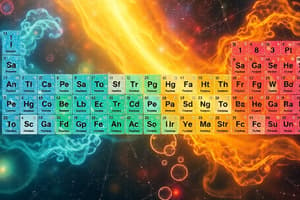Podcast
Questions and Answers
Which elements had complete outer shells?
Which elements had complete outer shells?
- Neon (correct)
- Argon (correct)
- Oxygen
- Helium (correct)
What do you notice about helium, neon, and argon?
What do you notice about helium, neon, and argon?
Far right - noble gases, unreactive outer
Which elements had only one valence electron?
Which elements had only one valence electron?
- Sodium (correct)
- Lithium (correct)
- Hydrogen (correct)
- Helium
What do you notice about hydrogen, lithium, and sodium?
What do you notice about hydrogen, lithium, and sodium?
What do you notice about the number of valence electrons as you move from left to right across a row or period in the periodic table?
What do you notice about the number of valence electrons as you move from left to right across a row or period in the periodic table?
What do you notice about the number of energy levels or shells as you move down a column or group?
What do you notice about the number of energy levels or shells as you move down a column or group?
What do you notice about the location of the elements in each family?
What do you notice about the location of the elements in each family?
In what family would you classify hydrogen?
In what family would you classify hydrogen?
Flashcards are hidden until you start studying
Study Notes
Noble Gases
- Helium, neon, and argon have complete outer electron shells.
- These elements are located on the far right of the periodic table and are classified as noble gases.
- Noble gases are characterized by their unreactive nature due to their full outer electron configuration.
Alkali Metals
- Hydrogen, lithium, and sodium are elements with only one valence electron.
- These elements are positioned on the far left side of the periodic table and belong to the alkali metal group.
- Alkali metals are known for having a single electron in their outermost shell, making them highly reactive.
Valence Electrons Across Periods
- The number of valence electrons increases as you move from left to right across a period in the periodic table.
- This pattern is consistent across all periods, indicating a relationship between position and electron configuration.
Energy Levels Down Groups
- As you move down a column or group in the periodic table, the number of energy levels or shells increases.
- This results in larger atomic radii and affects chemical reactivity and element properties.
Family Patterns
- Elements within the same family (or group) in the periodic table typically have one more outer electron than the element to its immediate left.
- This pattern helps classify elements based on their similar chemical properties.
Hydrogen Classification
- Hydrogen is classified as a non-metal because it is a gaseous element and exhibits reactivity.
- Despite being placed above alkali metals, its characteristics differ significantly from those of typical metals.
Studying That Suits You
Use AI to generate personalized quizzes and flashcards to suit your learning preferences.





